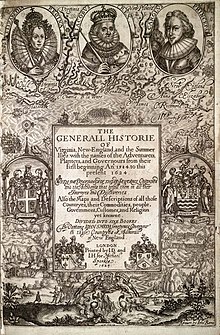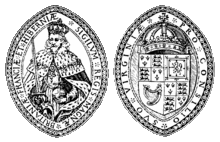Virginia Company
 The areas of the Virginia Company founded and organized by Bartholomew Gosnold of Grundisburgh in Suffolk, England and granted an exclusive charter by James I to the London and Plymouth companies; also showing the overlapping (yellow) area granted to both companies | |
Formerly | Plymouth Company London Company |
|---|---|
Type | joint stock company |
The Virginia Company refers collectively to two joint-stock companies chartered under James I on 10 April 1606[1][2][3] with the goal of establishing settlements on the coast of America.[4] The two companies are referred to as the "Virginia Company of London" (or the London Company) and the "Virginia Company of Plymouth" (or the Plymouth Company), and they operated with identical charters but with differing territories. The charters established an area of overlapping territory in America as a buffer zone, and the two companies were not permitted to establish colonies within 100 miles of each other. The Plymouth Company never fulfilled its charter, but its territory was claimed by England and became New England.
Contents
1 Differences between the two companies
2 The London Company
3 The Plymouth Company
4 Heraldry
5 See also
6 References
7 External links
Differences between the two companies
As corporations, the companies were empowered by the Crown to govern themselves, and they conferred that right to their colonies. The Virginia Company failed in 1624, but the right to self-government was not taken away and the principle was established that a royal colony should be self-governing. This formed the genesis of democracy in America.[5]
The original charter by King James in 1606 did not mention a Virginia Company or a Plymouth Company; these names were applied somewhat later to the overall enterprise. The Charter of 1609 stipulates two distinct companies, stating:
…that they shoulde devide themselves into twoe collonies, the one consistinge of divers Knights, gentlemen, merchaunts and others of our cittie of London, called the First Collonie; and the other of sondrie Knights, gentlemen and others of the citties of Bristoll, Exeter, the towne of Plymouth, and other places, called the Seccond Collonie….[6]
The eastern seaboard of America was named Virginia from Maine to the Carolinas; Florida was under Spanish dominion.[7][8][9] As corporations, the companies were empowered by the Crown to govern themselves; this right was not conferred onto the colonies themselves until the dissolution of the third Charter in 1621. The Virginia Company failed in 1624, but the right to self-government was not taken from the colony, and the principle was thus established that a royal colony should be self-governing, forming the genesis of democracy in America.[10][11][12]:90-91
The London Company

"The Generall Historie of Virginia, New-England, and the Summer Isles", by Capt. John Smith. The armorials of the Virginia Company are shown at far left
By the terms of the charter, the London Company was permitted to establish a colony of 100 miles square between the 34th and 45th parallels, approximately between Cape Fear and Long Island Sound. It also owned a large portion of Atlantic Ocean and inland Canada.
On 14 May 1607, the London Company established the Jamestown Settlement about 40 miles inland along the James River, a major tributary of the Chesapeake Bay in present-day Virginia. In 1620, George Calvert asked King James I for a charter for English Catholics to add the territory of the Plymouth Company. Also in 1609, a much larger Third Supply mission was organized. A new purpose-built ship named the Sea Venture was rushed into service without the customary sea trials. She became flagship of a fleet of nine ships, with most of the leaders, food, and supplies aboard. Notable persons aboard the Sea Venture included fleet Admiral George Somers, Vice-Admiral Christopher Newport, the new governor for the Virginia Colony Sir Thomas Gates, future author William Strachey, and businessman John Rolfe with his pregnant wife.
The Third Supply convoy encountered a hurricane which lasted three days and separated the ships from one another. The Sea Venture was leaking through its new caulking, and Admiral Somers had it driven aground on a reef to avoid sinking, saving 150 men and women and several dogs, but destroying their ship.[13] The uninhabited archipelago was officially named "The Somers Isles" after Admiral Somers, though it was known as Bermuda.[14] The survivors built two smaller vessels from salvaged parts of the Sea Venture which they named Deliverance and Patience.[15] Ten months later, they continued on to Jamestown, arriving at Jamestown on 23 May 1610 but leaving several men behind on the archipelago to establish possession of it. At Jamestown, they found that over 85% of the 500 colonists had perished during what became known as the "Starving Time". The Sea Venture passengers had anticipated finding a thriving colony at Jamestown and had brought little food or supplies with them. The colonists at Jamestown were saved only by the timely arrival three weeks later of a supply mission headed by Thomas West, 3rd Baron De La Warr, better known as "Lord Delaware".

Obverse and Reverse of the Seal of the King in his capacity as President of the Council of Virginia, the inscriptions signifying: "Seal of the King of Great Britain, France and Ireland"; "For his Council of Virginia"
In 1612, The London Company's Royal Charter was officially extended to include the Somers Isles as part of the Virginia Colony. However, the isles passed to the London Company of the Somers Isles in 1615, which had been formed by the same shareholders as the London Company.
To the disappointment of its investors, the Virginia Company of London failed to discover gold or silver in Virginia. However, the company did establish trade of various types. The biggest trade breakthrough came when colonist John Rolfe introduced several sweeter strains of tobacco[16] from the Caribbean,[17] rather than the harsh-tasting kind native to Virginia.[18] Rolfe's new tobacco strains led to a strong export for the London Company and other early English colonies, and helped balance a trade deficit with Spain.
The Jamestown Massacre which devastated that colony in 1622 brought on unfavorable attention, particularly from King James I who had originally chartered the Company. There was a period of debate in Britain between Company officers who wished to guard the original charter, and those who wanted the Company to be disbanded. In 1624, the King dissolved the Company and made Virginia a royal colony.[19]
The Plymouth Company
The Plymouth Company was permitted to establish settlements between the 38th and 45th parallels, roughly between the upper reaches of the Chesapeake Bay and the current U.S.-Canada border. On 13 August 1607, the Plymouth Company established the Popham Colony along the Kennebec River in present-day Maine. However, it was abandoned after about a year and the Plymouth Company became inactive. A successor company eventually established a permanent settlement in 1620 when the Pilgrims arrived in Plymouth, Massachusetts aboard the Mayflower.[citation needed]
Heraldry

Arms of Virginia Company, as depicted in John Stow's Survey of London (1632)
The armorials of the "Virginian Merchants" were: Argent, a cross gules, between four escutcheons, each regally crowned proper, the first escutcheon in the dexter chief, the arms of France and England, quarterly; the second in the sinister chief, the arms of Scotland; the third the arms of Ireland; the fourth as the first. The crest was: On a wreath of the colours, a maiden queen couped below the shoulders proper, her hair dishevelled of the last, vested and crowned with an Eastern crown or. The supporters were: Two men in complete armour, with their visors open, on their helmets three ostrich feathers argent, each charged on the breast with a cross throughout gules, and each holding a lance proper in his exterior hand. The Latin motto was: En dat Virginia quartam[20] (quintam[21]) ("Behold, Virginia gives a fourth (fifth) (dominion)"), recognizing the colony's status alongside the king's other three (four) dominions of England, Ireland, Scotland, and France (a heraldic fiction), and the Kingdom of Great Britain after the Acts of Union 1707.[22]
See also
- List of trading companies
References
^ Paullin, Charles O, Edited by John K. Wright (1932). Atlas of the Historical Geography of the United States. New York, New York and Washington, D.C.:: Carnegie Institution of Washington and American Geographical Society. pp. Plate 42.CS1 maint: Extra text: authors list (link).mw-parser-output cite.citation{font-style:inherit}.mw-parser-output .citation q{quotes:"""""""'""'"}.mw-parser-output .citation .cs1-lock-free a{background:url("//upload.wikimedia.org/wikipedia/commons/thumb/6/65/Lock-green.svg/9px-Lock-green.svg.png")no-repeat;background-position:right .1em center}.mw-parser-output .citation .cs1-lock-limited a,.mw-parser-output .citation .cs1-lock-registration a{background:url("//upload.wikimedia.org/wikipedia/commons/thumb/d/d6/Lock-gray-alt-2.svg/9px-Lock-gray-alt-2.svg.png")no-repeat;background-position:right .1em center}.mw-parser-output .citation .cs1-lock-subscription a{background:url("//upload.wikimedia.org/wikipedia/commons/thumb/a/aa/Lock-red-alt-2.svg/9px-Lock-red-alt-2.svg.png")no-repeat;background-position:right .1em center}.mw-parser-output .cs1-subscription,.mw-parser-output .cs1-registration{color:#555}.mw-parser-output .cs1-subscription span,.mw-parser-output .cs1-registration span{border-bottom:1px dotted;cursor:help}.mw-parser-output .cs1-ws-icon a{background:url("//upload.wikimedia.org/wikipedia/commons/thumb/4/4c/Wikisource-logo.svg/12px-Wikisource-logo.svg.png")no-repeat;background-position:right .1em center}.mw-parser-output code.cs1-code{color:inherit;background:inherit;border:inherit;padding:inherit}.mw-parser-output .cs1-hidden-error{display:none;font-size:100%}.mw-parser-output .cs1-visible-error{font-size:100%}.mw-parser-output .cs1-maint{display:none;color:#33aa33;margin-left:0.3em}.mw-parser-output .cs1-subscription,.mw-parser-output .cs1-registration,.mw-parser-output .cs1-format{font-size:95%}.mw-parser-output .cs1-kern-left,.mw-parser-output .cs1-kern-wl-left{padding-left:0.2em}.mw-parser-output .cs1-kern-right,.mw-parser-output .cs1-kern-wl-right{padding-right:0.2em}
^ Swindler, William F., Editor (1973–1979). Sources and Documents of United States Constitutions.' 10 Volumes. Dobbs Ferry, New York: Oceana Publications. pp. Vol. 10: 17–23.CS1 maint: Extra text: authors list (link)
^ Van Zandt, Franklin K. (1976). Boundaries of the United States and the Several States; Geological Survey Professional Paper 909. Washington, D.C.: Government Printing Office. p. 92.
^ How Virginia Got Its Boundaries, by Karl R Phillips
^ Andrews, Charles M. (1924). The Colonial Background of the American Revolution. New Haven and London: Yale University Press. pp. 32–34. ISBN 0-300-00004-9.
^ http://www.let.rug.nl/usa/documents/1600-1650/the-second-virginia-charter-1609.php
^ "Charter of the Virginia Company of 1606".
^ "Spanish Florida". Florida State, Dept of Library and Information Services.
^ "Charter of 1609".
^ Andrews, Charles M. (1924). The Colonial Background of the American Revolution. New Haven and London: Yale University Press. pp. 32–34. ISBN 0-300-00004-9.
^ "An Ordinance and Constitution of Treasurer and Company in England for a Council and Assembly in Virginia (1621)".
^ Gayley, Charles Mills (1917). "Shakespeare and the Founders of Liberty in America". Internet Archive. Retrieved 2018-11-30.
^ Woodward, Hobson. A Brave Vessel: The True Tale of the Castaways Who Rescued Jamestown and Inspired Shakespeare's The Tempest. Viking (2009) pp. 32–50.
^ A Discovery of The Barmudas, Sylvester Jordain
^ Woodward, Hobson. A Brave Vessel: The True Tale of the Castaways Who Rescued Jamestown and Inspired Shakespeare's The Tempest. Viking (2009) pp. 92–94.
^ "Welcome to Founders of America!". Archived from the original on 5 June 2007. Retrieved 25 May 2007.
^ Economics of Tobacco
^ Virtual Jamestown
^ The First Seventeen Years: Virginia, 1607–1624, Charles E. Hatch, Jr.
^ Fox-Davies, Arthur, The Book of Public Arms, 1919
^ As depicted on frontispiece to "The Generall Historie of Virginia, New-England, and the Summer Isles", by Capt. John Smith
^ [1]
- David A. Price, Love and Hate in Jamestown: John Smith, Pocahontas, and the Heart of A New Nation, Alfred A. Knopf, 2003
External links
- First Charter of Virginia – 10 April 1606 O.S.; Julian Calendar (from Julius Caesar time) or 1 April 1606 N.S.; Gregorian Calendar (Current Civil Calendar.)
- Second Charter of Virginia
- Richard Frethorne's Letters, bilingual (english/french)